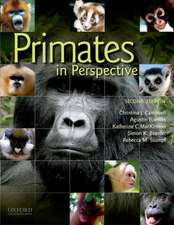Primate Societies: Group Techniques of Ecological Adaptation
Autor Hans Kummeren Limba Engleză Paperback – 15 dec 2006
| Toate formatele și edițiile | Preț | Express |
|---|---|---|
| Paperback (1) | 407.57 lei 6-8 săpt. | |
| Taylor & Francis – 15 dec 2006 | 407.57 lei 6-8 săpt. | |
| Hardback (1) | 997.93 lei 6-8 săpt. | |
| Taylor & Francis – 2 aug 2017 | 997.93 lei 6-8 săpt. |
Preț: 407.57 lei
Nou
Puncte Express: 611
Preț estimativ în valută:
78.01€ • 84.77$ • 65.57£
78.01€ • 84.77$ • 65.57£
Carte tipărită la comandă
Livrare economică 22 aprilie-06 mai
Preluare comenzi: 021 569.72.76
Specificații
ISBN-13: 9780202309040
ISBN-10: 0202309045
Pagini: 160
Ilustrații: 1
Dimensiuni: 152 x 229 x 13 mm
Greutate: 0.25 kg
Ediția:1
Editura: Taylor & Francis
Colecția Routledge
Locul publicării:Oxford, United Kingdom
ISBN-10: 0202309045
Pagini: 160
Ilustrații: 1
Dimensiuni: 152 x 229 x 13 mm
Greutate: 0.25 kg
Ediția:1
Editura: Taylor & Francis
Colecția Routledge
Locul publicării:Oxford, United Kingdom
Cuprins
1. Culture and the Conceptual Frame of Biology 2. An Introduction to Primate Societies 17 3. Adaptive Functions of Primate Societies 4. Ways of Adapting 5. How Flexible Is the Trait? 6. Man and Primates Compared
Descriere
In this book, Hans Kummer, one of the world's leading primate ethologists, examines the patterns of social interaction among primates







